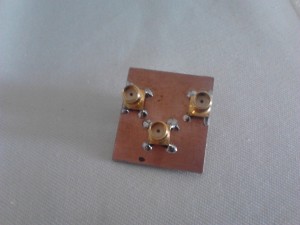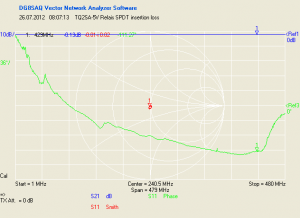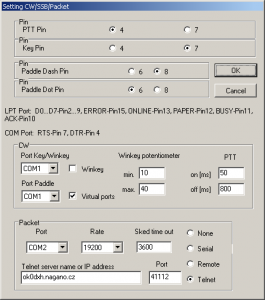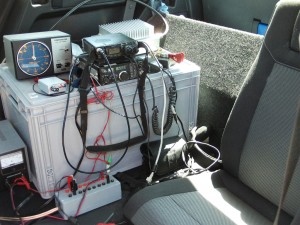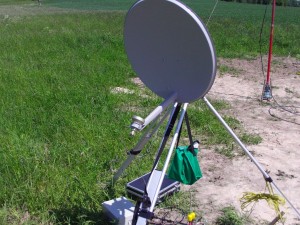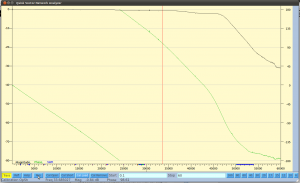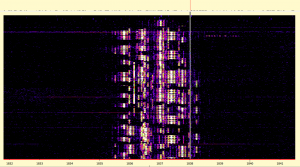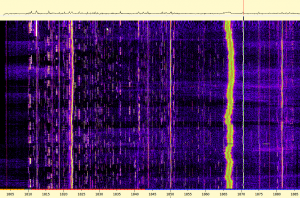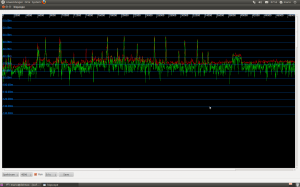I tried a cheap TQ2SA SMD relais for RF switching. The circuit was using the 2 switches as one SPDT switch with the unused output connected to ground.
Find some pictures attached. For low power it should be possible to use the relais up to 70cm (ok, 30dB isolation only). On 2m and below it works with good results…
Category Archives: Amateur Radio
Another 43km Laser trial
During July V/U/SHF contest another 43km laser communication trial with DK5WMA.
Locations were JO60LK and JO60MT during the sunset.
Find a short video taken at my location here:
V/U/SHF Contest meets D-Star
There is now a reflector group for V/U/SHF sked alignment especially during contest operation.
You find this on DCS001 reflector module U. Thanks to DG1HT !
http://xrf011.xreflector.net/dcs_info.htm
I will be qrv in this module during July V/U/SHF contest from JO60LK.
Windows-free V/U/SHF Contest
During V/U/SHF contests we use the logging software VUSC from OK1DIX. Is is a multi-operator network based log designed for contest operation. Since my last windows installation got destroyed by a stupid trojan i decided not to install windows anymore. So i tried VUSC under the Wine API emulator and it works very well.
Just download the binary here (current version is 6.32): http://www.ok2kkw.com/vusc4win_eng.htm
Install the binary. It should create a start icon on your desktop which is quite unusual for Linux. You can also start it directly from the Wine directory which is /home/
Please refer to the manual from Lada to see how it works.
The only thing that currently does not work is the export of EDI Log files from the internal used .DIX database. The reason is that the windows “copy” commandline tool is used to put some files together. This does not work with Wine for some reason. If you want to export your logs you have still to use Windows or a Windows in a virtual machine. If you find a different way just let me know ;)
VUSC features some very good SSB and CW contest keyer. In order to use this with Wine you need to do some adjustments. You need a serial port with access out of Wine.
I use a USB-serial converter for example. This shows up as /dev/ttyUSB0. Now create a symlink in the directory /home/
This makes a reference for Wine that it should refer to ttyUSB0 if com1 is selected. Take care that your user is in the group “dialout” in order to access the serial port.
Now you may do some settings to select the correct pins and ports for PTT and Key.
A paddle that is connected to the paddle input pins can be used together with the keyer functionality of VUSC. This works very well. But first try to get the PTT keyed if you press F1 in mode SSB and CW.
One thing you might experience is that the CW keying is weird and the timing of the dashes and dots is completely rubbish. In this case switch off the VUSC internal monitoring tone in the CW/SSB/Packet menue by unselecting “Toggle monitor”. Now the CW from VUSC should be fine.
One more hint: At my PC the PCMCIA-serial adapter from D-Link i usually use did not work. Probably the driver does not support pin toggling although i do not understand why. The USB-serial adapter works fine…
DUR with new mobile shack
DK7FC 136.8kHz longwave beacon
Just for luck i received the CW beacon of DK7FC from JN49IK on 136.8kHz this evening…
Video:
HiQSDR as VNA
Since today the HiQSDR or the original N2ADR frontend might be used as a vector network analyzer for the shortwave range.
Jim wrote a simple tool that displays amplitude and phase between TX port and RX port and can handle some calibration.
Currently it is quite simple and i do not have provisions to measure reflections yet, so i can just measure S21 at the moment.
But for the future it will be a nice feature to have the antenna analyzer built into the transceiver itself.
The picture below shows a simple ugly-style lowpass filter.
HK0NA 160m Pileup
CQ WW 160m CW
HiQSDR and HiQScope
Recently Jim, N2ADR released a new version of his FPGA code for the HiQSDR/N2ADR frontend. This brings improved TX filters that should now also support FM and DRM TX. Stefan, DL2STG ported his HiQScope extension to the new Verilog code. This made me want to give it a try. It is really impressive how this makes the HiQSDR a 60MHz Bandwidth spectrum analyzer with waterfall functionality. And it can run in parallel to the regular transceiver application.
The screenshots below show the unfiltered spectrum from a short mobile shortwave antenna. The big signals above 16MHz are images of the extreme strong FM radio stations that i have here. Below the shortwave radio bands can be seen.


